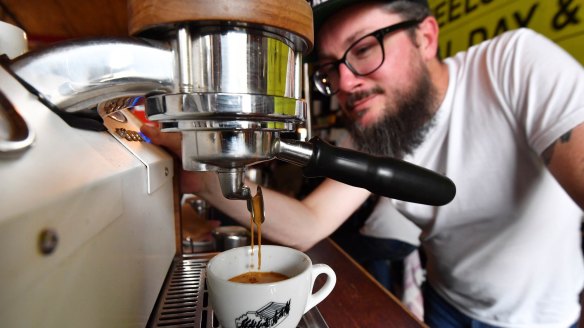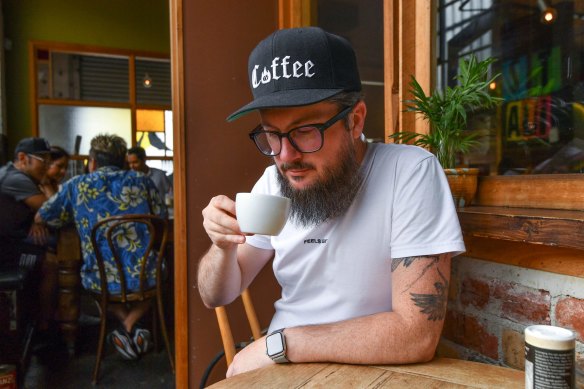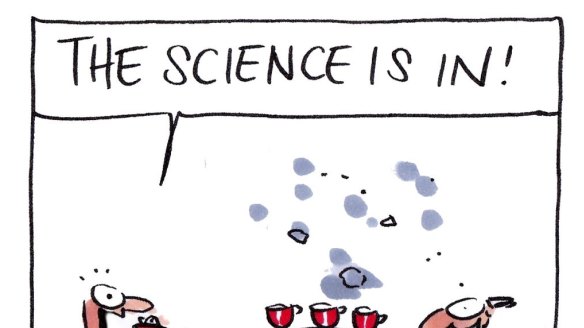International scientific study says your barista is making your coffee all wrong
A team of international scientists working with a Melbourne barista claim to have designed a scientifically perfect cup of coffee.
Their research, published in top journal Matter on Thursday, claims the immutable coffee laws Australia’s baristas live by, imposed by Italy's national espresso institute, are all wrong.
Our coffee maestros use too much coffee, apply too much water pressure and grind the beans too fine. That means many of the beans are under or over-extracted, producing an inconsistent shot.
The scientists' new method produces better coffee, and could save the average cafe almost $10,000 a year, they say.
“We were wasting coffee without even realising it,” says Michael Cameron, a barista and special projects manager at St Ali cafe, and the paper’s lead author.
Chasing the God Shot

Mr Cameron, like many coffee obsessives, has long chased the mythical ‘God Shot’ – an espresso so good you feel the presence of the divine. Four years ago, his search led him to Christopher Hendon.
Based at the University of Oregon’s chemistry department, Assistant Professor Hendon is probably the world’s leading coffee scientist.
He told Mr Cameron to try something heretical.

Espresso is always – always – extracted with a water pressure between 9 and 10 bars. The Istituto Nazionale Espresso Italiano, Italy’s national espresso institute, won’t certify anything else.
Ignore that, Dr Hendon said. Drop it to six bars.
“I cannot describe to you the first time I tried it,” says Mr Cameron. “It was like my brain just stopped and went, what the f--- am I drinking? It was amazing, the flavours I was getting.”

He told other baristas about his discovery. But they scoffed. “People were saying it wasn’t even espresso,” says Mr Cameron.
So he and Dr Hendon decided to prove their low-pressure coffee was better.
Dr Hendon enlisted a team of mathematicians, engineers and physicists from universities across the US, UK and Switzerland to build a mathematical simulation of how espresso is extracted.
Using the model they tested a range of tweaks to see what produced the best shot: changing the dose of coffee, water pressure, the grind size, the pressure from the tamp.
And every weekend, Mr Cameron would head into his cafe and try out the new settings.
Over and under-extracted
The model’s results confirmed low pressure was the way to go. But it suggested combining low pressure with finely ground coffee.
When Mr Cameron tried it, his machine choked. Dr Hendon was stumped. Was Mr Cameron doing something wrong?
He wasn’t. The problem was the model.
Further investigation revealed that when coffee was ground finely and then had water pushed through it at high pressure, some of the coffee was either over or under-extracted, while a large proportion did not come into contact with water at all.
At low pressure, the water couldn't get through at all.
“That’s how most espresso is served today: as a complex melange of over and under-extracted flavours. But what we have shown is that if you get an even extraction, you can get all the coffee – and it tastes better. Or at least I think it does,” says Mr Cameron.
Their solution: less pressure, less coffee, coarser grind, less water, quicker shot. That means all of the ground coffee comes into contact with the water. You get the same amount of espresso using less coffee – a 25 per cent gain in efficiency, the authors claim.
The scientists convinced a cafe in Oregon to switch to their science-coffee. By reducing the amount of coffee in each shot, the cafe saved $5293 a year in bean costs.
Of course, bean efficiency is not high on in the list of what people want in an espresso.
It is the over and under-extraction of flavours, combined, that gives coffee its some of its complexity.
A more efficient shot is likely to have less complexity, the scientists concede.
But they have a solution to that: brew two shots of espresso, one over-extracted and the other under-extracted, and mix them together. Genius.
Go on, ask your barista for one. If you dare.
Restaurant reviews, news and the hottest openings served to your inbox.
Sign up